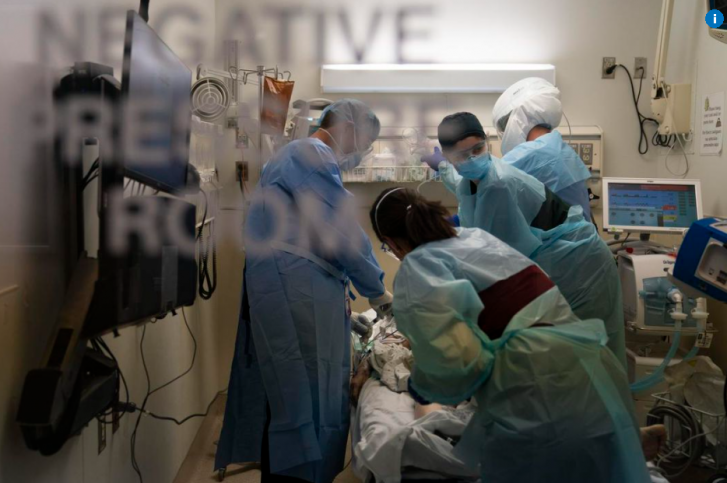Do you know what it feels like to drown? As water enters your nose, it burns your lungs as the air is choked from your body. You’re overcome with feelings of panic and helplessness as you struggle to survive. I nearly drowned a few years ago while swimming in the ocean. I remember the sheer terror as I was pushed under the waves while I fought to breathe.
Our COVID-19 patients are drowning. As a doctor on the front lines, I see it on their X-rays when their normally clear, black lungs are filled with white pockets of virus. I see it as they gasp for air while the infection chokes their bodies, depriving them of oxygen. I see it in their eyes as they clutch our hands in fear, begging us to help.

Our hospital is drowning. Every day we admit tens of patients to our wards and ICU with COVID-19. Teams of doctors, nurses and therapists are desperately trying to care for all of them. But it’s been more than a year and we are exhausted with no reprieve in sight. We transfer patients out to other hospitals, delay surgeries and repurpose different spaces so we can create beds for all the new sick patients. In our hospital COVID, literally, is everywhere. We are physically and mentally surrounded by it. The memory of the countless deaths and tragedies will forever haunt us.
Our health care system is on a collision course with disaster. Beds will run out. We will not have enough staff. More people will die.
All of this is because Ontario is drowning in a sea of systemic racism and discrimination. Since the beginning of the pandemic we have seen that the virus has disproportionately affected racialized and low-income populations — the same people who’ve worked tirelessly on the front lines putting food on our tables, delivering our packages and looking after our children and seniors. They have been indispensable. But we have not protected them.
The pandemic has overwhelmingly infected South Asian and Black Canadians. Asian Canadians have been attacked and blamed for a virus that is not their fault. Instead, the Ontario government has consistently failed to protect its most vulnerable citizens. Wealthy neighbourhoods like Rosedale and Forest Hill with the lowest rates of infection enjoy the highest levels of vaccination in the province. In contrast, those living in areas like Jane and Finch are five to 10 times more likely to be hospitalized or die from the virus, yet four times less likely to be vaccinated.
We saw this wave coming. We have been pleading for months for more equitable treatment and access. However, the government has acted too slowly and inadequately.
In addition to the recently announced measures, we need to reconsider what is truly an essential business while providing subsidies to all others that must close. During our previous lockdown earlier this year, it was estimated that two-thirds of the GTA population (more than two million individuals) were deemed “essential.”
While it is a great first step that we are targeting vaccinations to high-risk populations and essential workers by having mobile units going directly into these communities and workplaces, it still does not address the gorilla in the room — that of safe work environments and paid sick leave. We need to ensure access to rapid testing, personal protective equipment and improved ventilation. Workers need immediate access to funds in order to allow them time to get tested, self-isolate or vaccinated without losing income. The Canadian Recovery Sickness Benefit is not sufficient, because it is retroactive and requires that workers apply after they become ill. We need to correct the socioeconomic factors that have led us to this point, by investing in affordable housing, safe schools and ensuring workers are paid a living wage.
I was fortunate to have been thrown a lifesaver that day in the ocean. I will never forget what it feels like to be drowning. The fear overwhelms you. But right now Ontario is on a sinking ship and that terrifies me even more. We need decisive and equitable action now before this tsunami drowns us all. We cannot afford to wait for a lifesaver to arrive.
Article From: Toronto Star
Author: Dr. Stephanie Go, an internal medicine specialist in Toronto.

